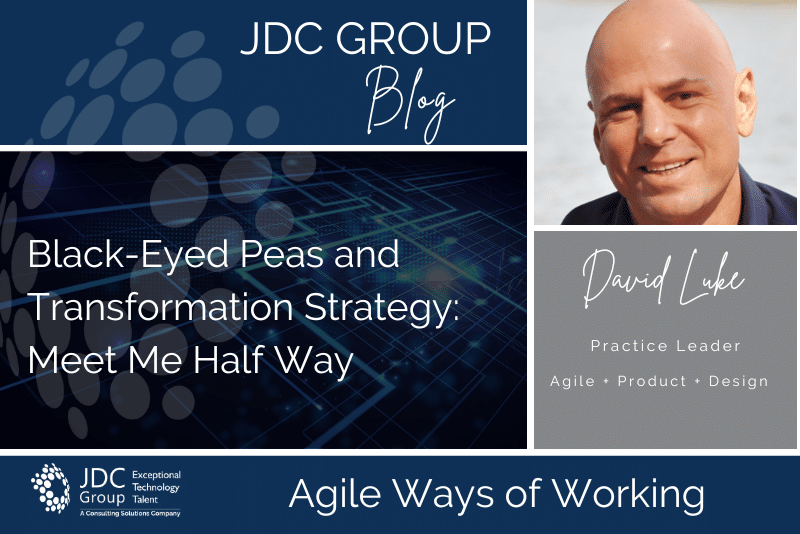So I’m an old school Black Eyed Peas fan—I love Fergie and will.i.am and their unique beats. Recently, I got nostalgic and broke out some of my old CDs. I was listening to “Meet me Halfway” and began to think about some of the recent conversations I’ve had with both my peers and clients.
When I visit clients, I typically hear things like – “We want to move to an XXX model,” “We want to implement a product model,” or “We can’t seem to hire and keep our Agile folks.” All of these are noble pursuits, but each must be approached with a manageable amount of change. It is important to explore the amount of change fatigue that an organization can handle as transformation isn’t a one size fits all. Cue The Black Eyed Peas to meet your client halfway and where they can gain a sense of grounding to launch.
Meeting your clients where they are when undergoing an Agile (or any) transformation is essential for several reasons. Agile transformations are not uniform, and tailoring the approach to the specific needs and context of your clients can significantly improve the chances of success. This simple concept will go miles toward gaining your client’s trust and buy-in as this is typically a significant change to their culture and organization. By acknowledging where they are, you gain agency with the client as they feel your empathy and start to understand the journey before them.
Following are several approaches that I have found to be super-successful:
Understand the current state of your client from a way of working, people, and culture.
By meeting clients where they are, you gain insights that will allow you to identify current anti-patterns, people mismatches, and areas of stress. Many organizations can change their culture but it’s a matter of creating a gradual and manageable change. Disruption is a good and necessary thing but move too fast and chances are good your efforts will be met with strong resistance. By understanding the state of change, you can identify and prioritize target areas and design a transformation strategy that fits the client’s unique circumstances.
Identify and address specific pain points and anti-patterns.
As each client faces its own set of challenges and pain points, collaboration and prioritization in these areas go a long way in meeting your client where they are. Often, there is a thorn in their side that they just can’t fix and addressing this may open the floodgates and reignite their passion and appetite for change. Oftentimes, I work with clients to address one specific anti-pattern that just needs a fresh set of eyes, ideas, and approaches. By taking a targeted, empathetic approach, we design a relevant strategy and course-correct.
Set realistic expectations with your clients.
I often hear “If we can just implement XXX model, I’m sure that we can get more production and better outcomes.” There are a few commercial Agile models available that are fantastic in that they provide clients with an organized method, great infographics, and certifications to accompany the models. As every client starts from a different level of maturity, attempting to jump too far ahead or having 100% alignment to one model may lead to disappointment or failure. Our approach is to understand the current state of the client, use aspects of various models, and create a unique way of working for each company. As everyone has a different culture and people, designing a realistic transformation approach is essential to success.
In summary, let’s not forget that an Agile transformation is not a one-time event but rather an ongoing journey of continuous improvement. Meeting clients where they are allows you to establish a starting point and then iteratively refine the process based on feedback and results. This allows you to tailor the process to their specific needs, culture, and context. It fosters trust, buy-in, and collaboration while ensuring a more successful and sustainable transformation journey.
